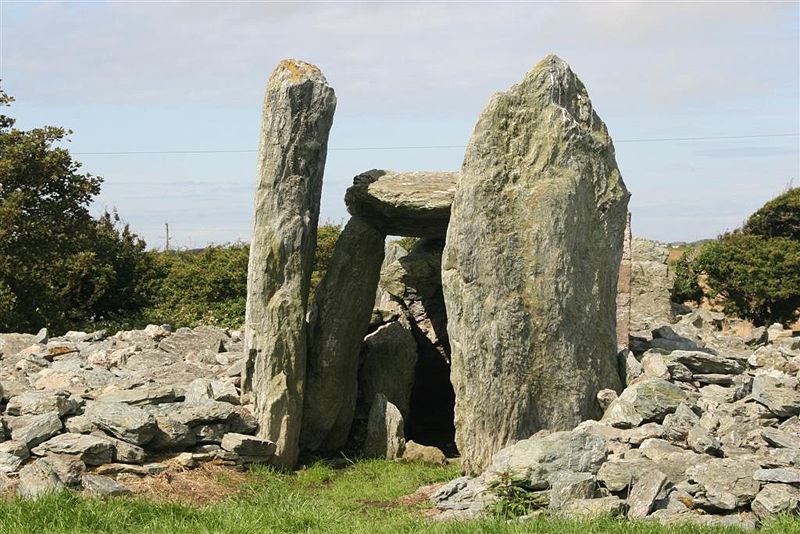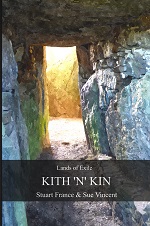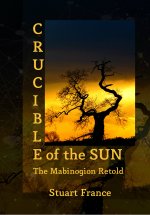
It didn’t look right, even from a distance. There was a forlorn, forgotten feel to the place, even though it is readily accessible and, to judge by the wearing of the mud by the gate, frequently visited. There was something decidedly ‘odd’ about the Presaddfed Neolithic burial chamber, something you could not help but notice as soon as you got to the kissing gate. For a start, the stones looked too big, too closely packed compared to all the other dolmens we have seen. For another thing, many of the stones themselves seemed to be distinctly different from each other and that is unusual in itself. It is not as if they are short of stone around here.

On closer inspection, we found that there are actually two chambered tombs, just a few feet apart. The northern chamber has fallen and is now little more than a jumble of stones. The tomb to the south consists of a really sturdy-looking horseshoe of stones supporting the capstone with the help if a delicate point of stone. The capstone is almost two feet thick and thirteen feet long and looks as if it has its front end missing… deliberately removed? Broken? Or just the shape in which it was found. That too looks odd. As if something is missing.

A lot of things are missing really. When it was documented in the Archaeological Journal in the 19th century, the two chambers were recorded as being surrounded by ‘a great number of small stones’. These are no longer in evidence. Nor is any trace of the mound that would always cover such a chamber, though there is evidence of a flattened mound or earthwork a short distance away that is intriguing in itself.

I have been unable to find any details of excavation reports at the site and little seems to be known about the tombs, other than that a family struck by poverty called them home for some time during the 18th when, it is to be hoped, the second chamber was still standing too. The massive blocks fit close together. The capstone is levelled, quite precisely, with small slivers of stone. The tight construction of the chambers would render them weatherproof, apart from draughts, except at the open end. Not much of a shelter, but far better than nothing at all.

The collapsed northern chamber now has only two of its uprights standing, but the capstone, leaning against them, has a thick layer of crystal running through it. It is possible that the north and south chambers were once enclosed in a single mound. It is a fairly unusual arrangement, although many such tombs have more than one chamber. A similar arrangement is found at the spectacular Trefignath tomb, just outside Treadddur, where archaeologists have been able to investigate and, through artefacts and dating techniques, establish the timeline for its construction. Trefignath was built in stages between 3750 and 3500 BC and it appears that Preseddfed dates to around the same era, although it may be as many as six thousand years old.
Continue reading here

Trefignath. Image by Porius1 (CCL)









































I have read that a lot of these sites were plundered for building materials in the 1800s. You’ll probably find all the missing stones in local manor houses.
LikeLike
We find them more in the village houses. Sometimes in churches…even in farm walls. A lot of the time they are broken and reused, but occasionally they use the whole huge standing stone.
LikeLike
‘…the reflection of a broken heart…’ … sad. 😦
LikeLike
That’s what it felt like.
LikeLiked by 1 person
S’what it looks like in the pics too
LikeLike
Maks you wonder why.
LikeLiked by 1 person
I’ll put my reply underneath my first comment, ‘cos this thread’s getting a bit narrow down here. 😀
LikeLiked by 1 person
… in response to Sue’s comment ‘Makes you wonder why’
Totally irreverent:
… two giantesses came down out of the hills one day and nabbed a couple of sheep for a wee bit of a stew. They set up their pot in a field and into it went the mutton. They sat back on some rocks they’d pulled from a crag over the hill and set out their pipes and mead to pass the time while their feast simmered.
Well, the mead was a particularly potent brew so when one of the giantesses got up to do a little tasting she had quite a list to the left.
“Pepper,” she said. “Needs more pepper.”
The other giantess, quite in her cups as well, threw the pepper pouch at her cousin with such force that it smacked into her head and split open.
With stinging eyes the giantess staggered around, tripped and fell onto the pot, cracking it wide open and burning her bum in the process. Enraged and blistered, she started to yell all sorts of nasty words, but the pepper found its way right up both her nostrils and she sneezed so hard, she broke the slabs of rock that she’d stacked together to make her seat
With their meal ruined both lasses decided that perhaps a slab of the berry pie they’d baked that morning back in their eyrie might better suit their appetites.
LikeLike
So… we blame the giants 🙂 Oddly enough, that may not be so far from the truth 😉 When you consider the forces of nature were often personified thus.
LikeLiked by 1 person